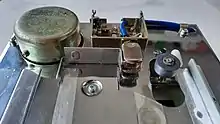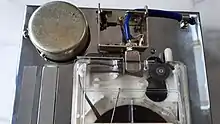 | |
| Media type | magnetic tape |
|---|---|
| Encoding | analog signal |
| Read mechanism | tape head |
| Write mechanism | magnetic recording head |
| Developed by | Earl Muntz |
| Usage | Car audio playback |


The Muntz Stereo-Pak, commonly known as the 4-track cartridge,[1] is a magnetic tape sound recording cartridge technology.
The Stereo-Pak cartridge was inspired by the Fidelipac 2-track monaural (audio & cue tracks, later 3-track for stereo) tape cartridge system invented by George Eash in 1954 and used by radio broadcasters for commercials and jingles beginning in 1959. The Stereo-Pak was adapted from the basic Fidelipac cartridge design by Earl "Madman" Muntz in 1962 with Muntz partnering with Eash, as a way to play prerecorded tapes in cars.[2][3][4]
The tape is arranged in an infinite loop which traverses a central hub and crosses a tape head, usually under a pressure pad to assure proper tape contact. The tape is pulled by tension, and spooling is aided by a lubricant, usually graphite.[5]
History
The endless loop tape cartridge was designed in 1952 by Bernard Cousino of Toledo, Ohio.[6][7]
Previously, music in the car had been restricted mostly to radios. Records, due to their methods of operation and size, were not practical for use in a car, although several companies tried to market an automobile record player including the Highway Hi-Fi and the Auto-Com flexidisc[8]
Entrepreneur Earl "Madman" Muntz of Los Angeles, California, saw a potential in these broadcast carts for an automobile music tape system, and in 1962 introduced his "Stereo-Pak 4-Track Stereo Tape Cartridge System" and prerecorded tapes, initially in California and Florida. He licensed popular music albums from the major record companies and duplicated them on these 4-track cartridges, or CARtridges, as they were first advertised.[8]
Music came in four cartridge sizes. 1 AA (single) size was an inch wide by two inches long and carried the same amount of time per track (6 minutes) as a 45 RPM EP per side. 2 A size, 4 inches wide by 5 inches long the most common was the same size as the vast majority of NAB (Fidelipac) carts and able to carry a 3-inch reel. 3 B size, six inches wide by 7 inches long was used very infrequently for 2-LP sets and other extended programs and able to carry a 5-inch reel. 4 C size, the largest, able to carry a full 1800-foot 7-inch reel of one-mil tape, used also very infrequently for extremely extended 4-LP sets.
Muntz also developed and marketed a variety of mobile and stationary players and recorders for his 4-track tapes.[9]
The B-and C-size carts would have their stereo sound split to mono and be used for background music systems all the way up to the early `90s when digital took over. In the last part of that period, a last-ditch effort to reduce cost came in the form of reducing the tape speed first to 1-7/8 IPS and then to 15/16 IPS while reducing the cartridge size first back to the standard widely available A-size and then to a hybrid size between the AA (single) size and the standard A-size. First Chromium high-bias tape was used to offset the loss of fidelity from the lower speed, and then when that proved too expensive, cobalt-based tape was substituted.
After riding in Muntz's car, listening to his 4-track cartridge system, electronics and aerospace entrepreneur Bill Lear had the a staffer at Lear Jet Corporation create a modified derivative, resulting in the more convenient and long-playing 8-track cartridge system, which quickly supplanted and surpassed the 4-track in the market -- until being surpassed, itself, by the cassette tape system.[2]
References
- ↑ "The 4-Track Madman". Archived from the original on July 16, 2004. Retrieved July 7, 2004.
- 1 2 "Analog Stereo Formats". Archived from the original on November 2, 2011. Retrieved October 28, 2011.
- ↑ Jay Ehler: Earl Muntz Meets George Eash Billboard vol. 84, No. 47, 18 November 1972, p. 62, 76, 78
- ↑ Barry Kernfeld: Pop Song Piracy: Disobedient Music Distribution since 1929, The University of Chicago Press 2011 ISBN 978-0-226-43183-3
- ↑ Magnetic sound recording tapes, 1963-04-02, retrieved 2018-05-02
- ↑ Morton, David (2006). Sound Recording: The Life Story of a Technology. JHU Press. p. 157. ISBN 9780801883989.
- ↑ Magnetic sound tape, 1955-04-11, retrieved 2018-05-02
- 1 2 "Auto-com Talking Book Demonstration Flexible Disc Auto-Disc". YouTube. Archived from the original on 2021-12-05.
- ↑ "Muntz", "Tape Recorder Directory," HiFi / Stereo Review's Tape Recorder Annual 1968, page 96, retrieved May 22, 2023. (Details on various Muntz 4-track players and recorders, with photos)